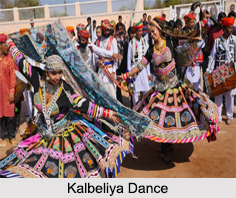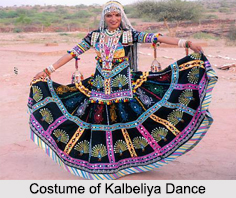 Kalbeliya Dance is a folk dance of Rajasthan. It is well known by other names like "Sapera Dance" or "Snake Charmer Dance". It is one of the most sensuous dance forms of Rajasthan. The folk dance is mainly performed by the Kalbeliya community. It is danced to celebrate the happy moment in the community. Both men and women participate in Kalbeliya dance. There is no organized training school, manuscripts or any written text to teach and learn Kalbeliya songs and dance. This folk art is transmitted from generation to generation. The popularity of Kalbeliya Dance is so much worldwide that it is now a part of the UNESCO"s Intangible Cultural Heritage of Humanity from the year 2010.
Kalbeliya Dance is a folk dance of Rajasthan. It is well known by other names like "Sapera Dance" or "Snake Charmer Dance". It is one of the most sensuous dance forms of Rajasthan. The folk dance is mainly performed by the Kalbeliya community. It is danced to celebrate the happy moment in the community. Both men and women participate in Kalbeliya dance. There is no organized training school, manuscripts or any written text to teach and learn Kalbeliya songs and dance. This folk art is transmitted from generation to generation. The popularity of Kalbeliya Dance is so much worldwide that it is now a part of the UNESCO"s Intangible Cultural Heritage of Humanity from the year 2010.
Kalbeliya Tribe of Rajasthan
The Kalbeliya is a snake-charmer community from Rajasthan. This distinctive and fascinating community is deeply rooted in the legacy of Sage Kanifnath. Legend has it that this revered sage achieved divine powers by consuming a bowl of poison, granting him the ability to control venomous snakes and animals. Divided into two main groups, the Daliwal and Mewara, the Kalbelias have a rich history of leading a nomadic lifestyle, migrating frequently from one place to another in ancient times.
At the heart of their traditional occupation lies the art of catching snakes and trading snake venom. Moreover, they are known to rear various animals, including snakes, dogs, hens, horses, donkeys, pigs, and goats. This close association with serpents is reflected in their unique dance movements and traditional costumes, which bear a striking resemblance to the graceful movements of these reptiles.
Throughout history, the Kalbelias have been referred to by different names such as Sapera, Jogira, Gattiwala, and Poogiwara. The largest cluster of Kalbelias resides in the Pali district, with significant communities in Ajmer, Chittorgarh, and Udaipur districts and Jaipur as well. As members of a scheduled tribe, they lead a nomadic lifestyle and typically inhabit temporary settlements called "deras."
Traditionally, Kalbelia men would carry cobras in cane baskets, traversing villages, while their women would sing, dance, and seek alms. It is noteworthy that the Kalbelias have a profound reverence for cobras and staunchly advocate for their protection, discouraging any harm to these sacred reptiles. Whenever a snake accidentally entered a home, the Kalbelias would be summoned to capture it without causing harm and safely relocate it to a more suitable location. Their presence and expertise have played a vital role in fostering harmony between humans and serpents in the regions they serve.
The Kalbelias have lived on the fringes of society for generations, residing in areas outside the villages they visit. This lifestyle has afforded them an intimate knowledge of the local flora and fauna, leading to a deep understanding of herbal remedies for various ailments, which serves as an alternative source of income for the community.
However, the enactment of the Wildlife Act of 1972 has significantly impacted the traditional occupation of snake handling, forcing the Kalbelias to seek alternative livelihoods. As a result, performing arts have emerged as a major source of income for them, gaining recognition both within India and beyond. Nevertheless, the availability of performance opportunities is sporadic, often reliant on seasonal tourism. As a consequence, some Kalbelia community members engage in agricultural work or cattle grazing to sustain themselves.
Religiously, the Kalbelias identify as Cultural Hindus and hold snake worship in high regard. They revere and worship Naga and Manasa, with Naga Panchami being a particularly significant holy day for them. Notably, the Kalbelias uphold distinct traditions that set them apart from the majority of Hindus. For instance, Kalbelia men wear a traditional ornament known as Apadravya. Furthermore, in contrast to the mainstream Hindu practice of cremation, the Kalbelias bury their deceased loved ones.
In matters of matrimony, the Kalbelias follow unique customs. The groom is required to pay a price to the bride`s father as part of the marriage, while the groom`s father, in turn, bears the expenses of the wedding ceremony.
Despite facing challenges and undergoing transitions, the Kalbelias continue to preserve their rich cultural heritage. Their way of life stands as a testament to India`s diverse traditions and customs, reflecting a harmonious coexistence with nature and a remarkable bond with serpents that remains both unique and awe-inspiring.
 Performance of Kalbeliya Dance
Performance of Kalbeliya Dance
In Kalbeliya Dance, males play various traditional and folk instruments and females perform the dance. Kalbeliya Dance is usually performed by a group of two women standing in the centre of the stage. After this pair, another pair of women come and dances in the same way. As the women dancers move in a circle, while dancing, their body sway acrobatically, leaving an impression that they are made up of some flexible material like rubber. Their dance movement resembles that of the snakes. The beat of the dance increases in tempo and also there is an increase in their pace of the dance. Their perfect movements to the enchanting tune of musical instruments are a treat to the eyes.
Male participants take care of the musical part of the dance. They use different instruments like Pungi, Dufli, Been, Khanjari, Morchang, Khuralio and Dholak to create the rhythm on which the dancers perform. The performance relies heavily to the music of the "Pungi", the "Dufli" and the plaintive notes of the "Been", the wooden instrument of the snake charmers.
The dancers are required to constantly decrease the tempo of their gyrations and move to the corners to catch their breath while two other dancers would spin around to take their places in the centre. The specialty of this dance is that the dancers perform it in a beautiful synchronized rhythm.
Elements of Kalbeliya Dance
The captivating Kalbeliya folk dance finds its expression through the graceful movements of female performers, set to the enchanting tunes of the Been. This lively dance form is an integral part of joyous occasions within the Kalbelia community. Unlike many other dance forms, Kalbelia dance lacks any organized training system, schools, manuscripts, or written texts dedicated to teaching and learning its songs and movements. Instead, this traditional folk art is passed down from one generation to another through the oral tradition, ensuring its preservation and continuity over time.
Costume of Kalbeliya Dance
The Kalbeliya women dancers wear an Angrakhi on the upper part of the body and an Odhani on the head. They wear a long, black coloured and heavily embroidered skirt called Ghagra on the lower body which has a wide circumference. This complete dress of Kalbeliya Dance is essentially black in colour with the decorative laces and mirror works to resemble a black snake with white spots or stripes. Kalbeliya dancers wear lots of traditional jewellery.
Songs Accompanying Kalbeliya Dance
The songs that accompany the Kalbeliya dance serve as a conduit for disseminating mythological knowledge through captivating stories. These songs also showcase the remarkable poetic prowess of the Kalbeliya community, renowned for their ability to spontaneously compose lyrics and improvise melodies during their performances. Passed down from one generation to the next, these songs and dances are an integral aspect of the Kalbeliya`s oral tradition, with no existing texts or training manuals to guide their transmission and preservation.



















